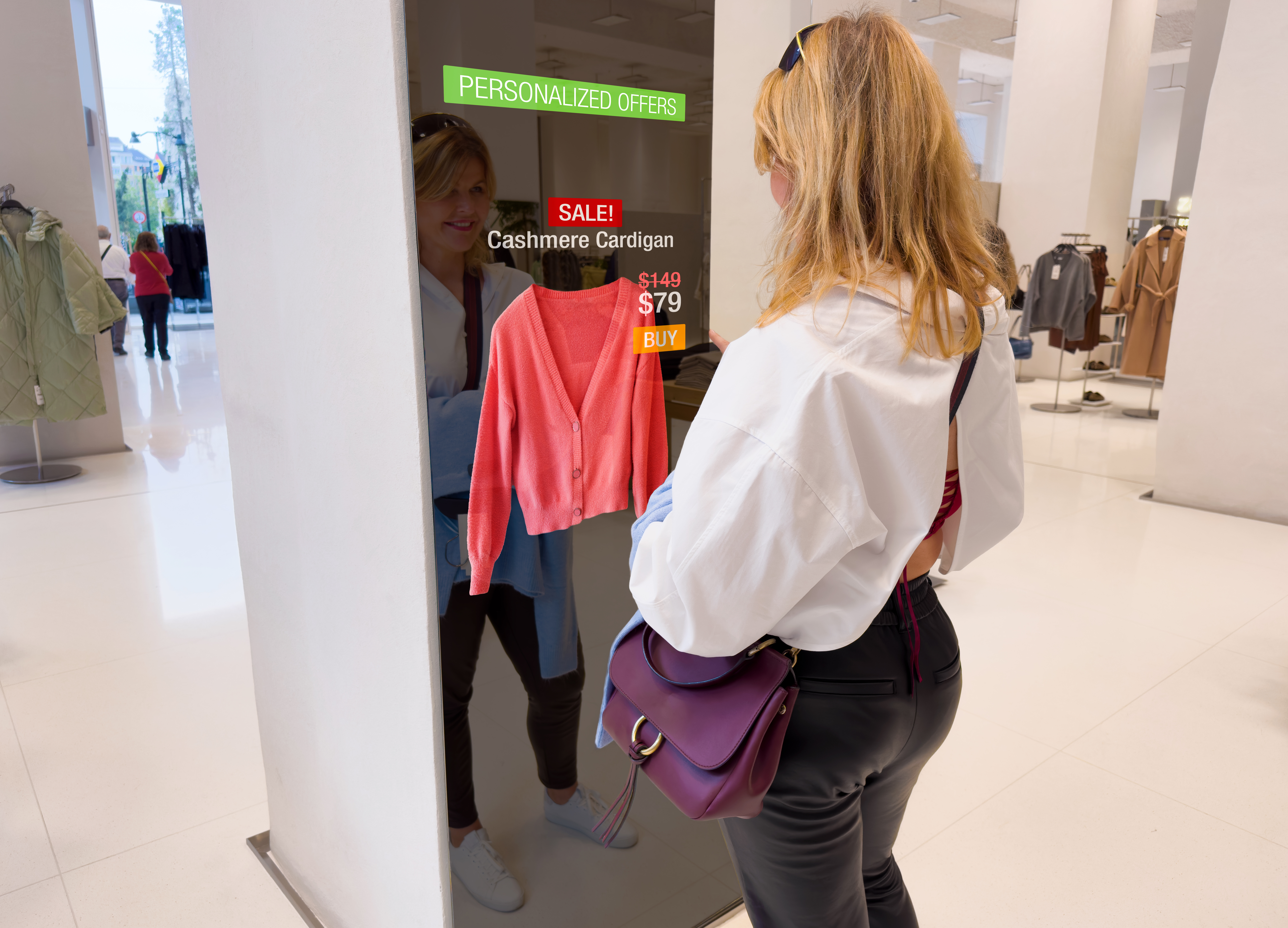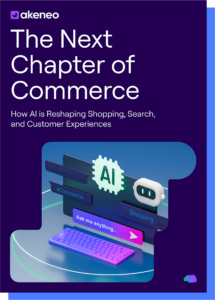Predicting the future of eCommerce is no simple task, but 2026 is already shaping up to be a year where technology and human experience collide in exciting ways. Discover the trends that are set to transform how we discover, purchase, and interact with products in the new year, from smarter AI-driven search tools and conversational checkouts to transparent supply chains and the ever-growing influence of social media.

Table of Contents
Predicting the future is a tricky business. If we’d asked an expert in 2016 what shopping would look like today, they probably would’ve imagined drones dropping off Amazon boxes by the hour and smart fridges automatically restocking our oat milk.
Some of that’s happened (sort of), but the truth is, technology always surprises us, especially in eCommerce. Every year brings a new twist, and 2026 looks like it’s going to be one of the most fascinating yet.
That’s why we’re donning our futurist hats; not the shiny sci-fi kind, but the practical kind that marketers, retailers, and digital innovators wear when they try to spot what’s coming next. We’re analyzing real data, evolving consumer behavior, and the technologies already reshaping how we browse, buy, and engage in order to peer into the crystal ball and see what’s on the horizon.
From AI-powered search tools that know your taste better than your best friend, to digital passports that tell the life story of your favorite products, here’s what’s about to redefine eCommerce as we head into 2026.
Traditional online search sometimes feels like shouting into the void. You type in a few keywords, cross your fingers, and hope the algorithm understands you. But for many shoppers, those days are over. The new era of eCommerce is powered by artificial intelligence that can actually infer and understand what you’re looking for, even when you don’t.
AI-driven discovery is already transforming how consumers browse, compare, and decide what to buy. 49% of Americans say AI recommendations already influence what they buy, and 64% of people say they’re willing to purchase items recommended by generative AI. SEMrush even predicts that AI-powered search will overtake traditional search as the preferred choice by 2028.
Visual search is also expected to keep gaining traction too, as consumers upload photos of something they saw on social media and find near-identical matches in seconds. Retailers are using these systems to personalize experiences in real time, learning from browsing behavior, preferences, and even mood signals to fine-tune recommendations.
We know—two AI trends in a row. But before your eyes glaze over, hear us out: if AI-driven search is about helping people find the right product, then large language model (LLM)-based purchasing is about helping them buy it without ever touching a checkout page.
LLMs like ChatGPT can now recommend products, compare features, and even complete purchases, all within a single chat. While this may sound futuristic, the adoption curve is already steep. A recent TechRadar report found that about one-third of U.S. consumers would let AI make purchases for them, and nearly a third have already used ChatGPT to assist in buying decisions.
Here’s how it might look in 2026: you tell your favorite AI assistant, “I need a gift for my dad—something under $100, and he loves gardening.” The assistant instantly pulls options from verified retailers, checks delivery dates, and finalizes the purchase, all while you sip your coffee.
For brands, this opens a brand new sales channel. Of course, this shift also raises important questions about data privacy, consent, and how to maintain human connection when algorithms start handling transactions. But there’s no denying the momentum: AI may be helping us to shop today, but in the coming years, it will start to simply shop for us.
While AI tends to steal the headlines, another quietly revolutionary change is coming to eCommerce in 2026: the rise of the Digital Product Passport (DPP). Think of it as a digital birth certificate for every product, detailing where it was made, what it’s made of, and how it can be reused or recycled.
Driven by the European Union’s Ecodesign for Sustainable Products Regulation (ESPR), DPPs are set to become mandatory for certain product categories beginning in 2026 and 2027. These digital records will accompany items throughout their entire lifecycle, from raw materials to end-of-life, helping consumers make informed, sustainable choices.
For brands, this is both a compliance challenge and a storytelling opportunity. Consumers increasingly want to know the “why” behind what they buy; where it came from, who made it, and what impact it has. With DPP, a customer will be able to scan a QR code on a sweater and see its full history: which factory produced it, how much carbon it generated, and how to recycle or repair it later.
By 2026, expect to see Digital Product Passports popping up across Europe and beyond. And once consumers get used to this level of visibility, there’s no going back.
See how Akeneo & Ocode can help you create Digital Product Passports.
Between 2023 and 2025, the number of social shoppers in the U.S. grew from roughly 96 million to 104 million. By 2026, those numbers will soar even higher, with TikTok alone projected to have nearly 40 million buyers in the U.S.
This growth isn’t surprising when you consider how people, especially younger audiences, discover products. Today, 43% of Gen Z consumers start their online shopping searches on TikTok, surpassing even Google and Amazon. Social media has become the new mall, where product discovery, community engagement, and purchasing all happen in one place.
User-generated content (UGC) also plays a massive role in this transformation. Shoppers trust people who look and talk like them more than polished brand campaigns. Reviews, unboxings, and “TikTok Made Me Buy It” videos are today’s word of mouth, and they convert at remarkable rates. Live shopping events, creator collaborations, and shoppable posts blur the line between entertainment and eCommerce, making shopping feel less transactional and more experiential.
By 2026, expect social commerce to become fully normalized. Platforms like Instagram, TikTok, and YouTube are continuing to refine in-app checkout options, allowing users to buy instantly without leaving their feeds.
At the same time, brands are learning to co-create with their audiences, turning customers into advocates and content creators. The result? A more authentic, community-driven form of commerce, where a single viral video can sell out a product overnight.
With all this talk about AI and digital transformation, you might think physical retail is dead. Spoiler alert: it’s not even close. In fact, hybrid shopping, where customers fluidly move between online and in-person touchpoints, has quickly become the norm.
Consumers still crave tangible experiences, and the data proves it. In a recent consumer survey we conducted here at Akeneo, we found that 75% of shoppers have bought something in-store after researching for it online, and 65% have done the opposite; purchasing a product online after browsing for it in a physical location.
In 2026, the most successful brands will be those that seamlessly blend the physical and digital worlds. Physical stores are already starting to evolve into experiential hubs: places to see, touch, and interact with products, to attend brand events, or even to process online returns with ease.
With so many advancements with the online shopping journey, it’s important to ask what’s driving this in-person surge? While consumers believe that algorithms can predict their preferences, they can’t fully replace the satisfaction of walking out of a store with your purchase in hand. For many consumers, that tactile joy will always matter. The smartest retailers aren’t choosing between physical and digital, but are designing ecosystems that make both shine.
Predicting the future of eCommerce may always involve a bit of educated guesswork, but one thing is certain: every major trend on the horizon depends on one thing above all else: great product data.
AI can’t recommend the right product if the underlying information is incomplete. Digital Product Passports can’t deliver transparency if product data is scattered across systems. Social commerce doesn’t work if your product descriptions, visuals, and attributes aren’t optimized for each channel. And hybrid experiences crumble without a unified, accurate source of truth about your products.
In 2026, success will belong to the brands that build a solid data foundation first. Reliable, enriched, and structured product information is what turns innovation into impact.
So while no one can perfectly predict what’s next in eCommerce, we can prepare for it. The future may be powered by AI and automation, but it runs on something far more fundamental: trustworthy product data. Get that right, and whatever the next big thing turns out to be, you’ll already be ahead of the curve.
Discover how AI is transforming shopping, search, and product experiences, and why clean, structured data is the key to staying competitive in the next era of commerce.
